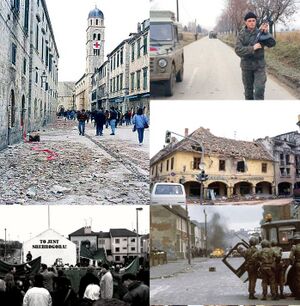Srebrogora conflict
| Srebrogóra conflict | ||||||||
|---|---|---|---|---|---|---|---|---|
 Clockwise: Mionica village center after the shelling, Srebrogóra People's Army soldier, a damaged house in Čakovice village, Nikolian Royal Army standoff with the rebels, Srebrogóra Popular Movement rally in Koševo. | ||||||||
| ||||||||
| Belligerents | ||||||||
|
Nikolian security forces |
Nikolian loyalist paramilitaries |
Srebrogóra paramilitaries | ||||||
| Casualties and losses | ||||||||
|
NAF: 902 Nikolian Police: 74 Žandarmerija: 42 Total: 1,018 |
ŠVG: 112 CDF: 542 TSC: 54 Total: 708 |
SPA: 659 SLF: 521 SPM: 78 Total: 1,258 | ||||||
|
Civilians killed: 2,347 (incl. ex-combatants 2,402) Civilians displaced: ~50,000 Total number of casualties: 5,331 | ||||||||
The Srebrogóra conflict (Serbian: Srebrogorski sukob, Mazurian: Konflikt srebrogórski) was a sectarian conflict that took place in southeastern Nikolia at the end of the 20th century. The conflict is often characterised as irregular war, and is commonly referred to as Srebrogóra Civil War.
The conflict was mostly ethnic and nationalist, fuelled by historical events. In 17th century, Srebrogóra voivodeship lost territories to the neighbouring voivodeships in Zlatarje war, which left many citizens that were acknowledging themselves as Srebrogórans under the rule of Šumadijan and Cerevian voivodeships. The struggle to return the original ethnic borders persisted throughout centuries, and culminated after a nationalist party, Srebrogóra Popular Movement won the elections for the Voivodeship government, and triggered a series of protests along the contested territory, which later progressed to civil disobedience and armed conflict between the formed paramilitary forces.
The main belligerents in the Srebrogóra conflict were Srebrogóra paramilitaries, whose role was to, through insurgency and armed rebellion forcefully change the borders of the Srebrogóra Voivodeship. They were contested by paramilitary groups from neighbouring voivodeships that assembled to defend their voivodeship borders. The Nikolian Police and Žandarmerija were the first Nikolian security forces that were present as the conflict started, and as the situation culminated into an armed rebellion, the Nikolian Armed Forces were deployed with purpose of restoring peace and constitutional order in the area.
An estimate of 5,331 people were killed in the conflict, about a half of them being civilians. The conflict also displaced more than 50,000 people, and created an even larger segregation between the two ethnicities. The conflict ended on 1st March 1996 after the signing of Treaty of Rakowice, which followed a disarmament of all paramilitary groups and withdrawal of Nikolian troops from the area. As a measure of security, additional police patrols were established around the areas where most of the conflict took place, and walls and watchtowers were erected between the two communities.